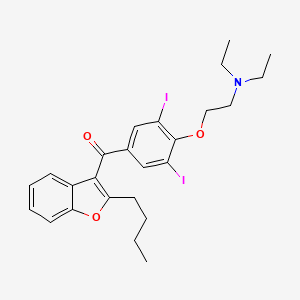|
Name: Amobarbital
Type: Barbiturate
AKA: Amytal, Tuinal

|
|
II. Natural Derivative
Synthetic substance, no natural derivative
 |
|
III. Chemical Profile (IUPAC name)

|
|
IV. History
Amobarbital, a barbiturate, was developed in the 1920s for its sedative and hypnotic effects. It was used to treat anxiety and insomnia but has been largely replaced by newer medications due to concerns about addiction and overdose.

|
|
V. Legal Information
Amobarbital, a barbiturate, is classified as a Schedule II controlled substance in the US, allowing limited medical use but reflecting high abuse potential. It is similarly regulated in many countries due to its potent sedative effects. The UNODC emphasizes the need for balanced regulation to ensure safe medical use while preventing misuse.
US Federal Schedule - II
Schedule II drugs, substances, or chemicals are defined as drugs with a high potential for abuse, with use potentially leading to severe psychological or physical dependence. These drugs are also considered dangerous. Some examples of Schedule II drugs are: combination products with less than 15 milligrams of hydrocodone per dosage unit (Vicodin), cocaine, methamphetamine, methadone, hydromorphone (Dilaudid), meperidine (Demerol), oxycodone (OxyContin), fentanyl, Dexedrine, Adderall, and Ritalin.
Key US Federal Policies:
Controlled Substances Act. Public Law: Public Law 91-513 (text can be found on GovInfo) (https://www.dea.gov/drug-information/csa). Date enacted: October 27, 1970.
|
|
VI. Physical Effects
Amobarbital is a barbiturate used for sedation and sleep induction. It acts as a downer, causing sedation and reduced consciousness. Short-term use is effective for managing sleep disorders, but long-term use may lead to dependence and cognitive issues. Overdose risks include severe sedation and respiratory depression. Safe use requires careful dosing and medical supervision. Recent research focuses on its efficacy and safety compared to other sedatives.  |
|
VII. Psychological Effects
N/A
 |
|
VIII. Culture
Amobarbital is a barbiturate used for its sedative and hypnotic effects. Its cultural significance lies in its historical use as a sleep aid and its potential for abuse. Media coverage often discusses its risks, including addiction and overdose. Amobarbital is used both recreationally and medicinally, contributing to discussions about barbiturate use and drug regulation.
 |
